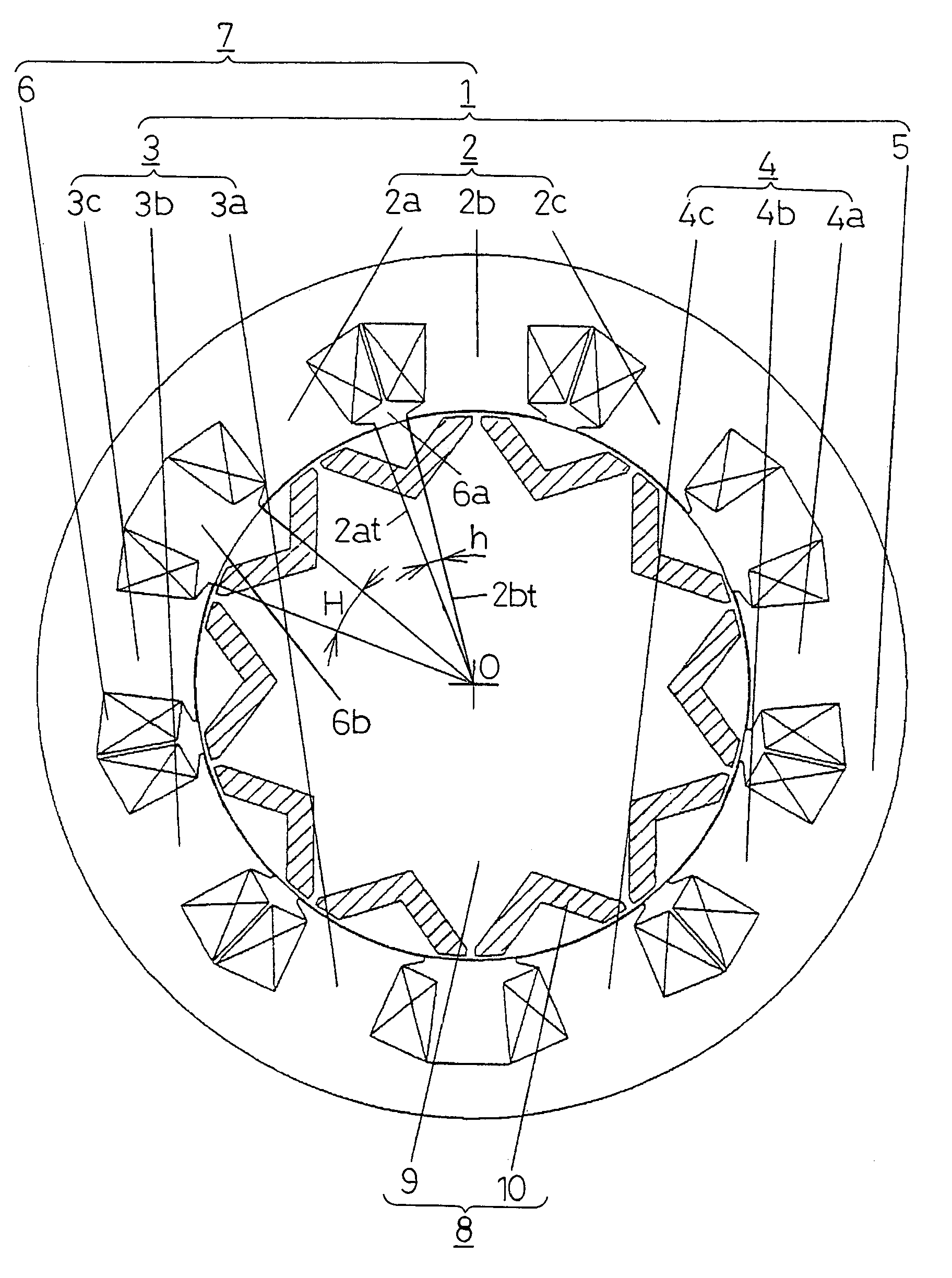Motor
a motor and motor technology, applied in the direction of rotating magnets, synchronous machines with stationary armatures, windings, etc., can solve the problems of reducing efficiency, observing waveform distortion in the counter electromotive voltage, and not knowing the actual application of the disclosed methods to automobiles. , to achieve the effect of increasing torque, increasing size, and increasing waveform distortion
- Summary
- Abstract
- Description
- Claims
- Application Information
AI Technical Summary
Benefits of technology
Problems solved by technology
Method used
Image
Examples
embodiment 1
[0052]FIGS. 1 to 4D are views for use in illustration of a motor according to Embodiment 1 of the present invention. FIG. 1 is a sectional view of a main part in a plane orthogonal to the central axis of the rotating shaft for the purpose of illustrating the motor main part, FIG. 2 is a development for use in illustration of the direction in which coils are wound around stator teeth, FIG. 3 is a view for use in illustration of how coils wound around stator teeth are connected, and FIGS. 4A to 4D are sectional views of the shapes of permanent magnets embedded in rotor cores and other examples of the rotor cores.
[0053]In FIG. 1, a stator core 1 includes a plurality of stator teeth 2a, 2b, 2c, 3a, 3b, 3c, 4a, 4b, and 4c, and a stator yoke 5 that connects the stator teeth 2a to 4c at one end. A coil 6 is wound around each of the stator teeth 2a to 4c, and the stator core 1 and the coils 6 form a stator 7.
[0054]The stator teeth 2a to 4c are divided into three groups in total, each of whi...
embodiment 2
[0071]FIGS. 5 to 7 are views for use in illustration of a motor according to Embodiment 2 of the present invention, FIG. 5 is a top view of a stator core, FIG. 6A is a partially enlarged view showing a part of FIG. 5 being enlarged, FIG. 6B is a partially enlarged view showing a part of a modification of the stator core being enlarged, and FIG. 7 is a enlarged view showing a modification of the tip end of a stator tooth.
[0072]In FIG. 5, a stator core 41 includes stator teeth 42a, 42b, 42c, 43a, 43b, 43c, 44a, 44b, and 44c, and a stator yoke 45 that connects these stator teeth 42a to 44c at one end. Similarly to Embodiment 1, the stator teeth 42a, 42b, and 42c form a group 42, the stator teeth 43a, 43b, and 43c form a group 43, and the stator teeth 44a, 44b, and 44c form a group 44. The coils (not shown) wound around the stator teeth in the groups 42, 43, and 44 form U, V, and W phases, respectively. Similarly to Embodiment 1 described above, the directions in which coils are wound a...
embodiment 3
[0083]FIGS. 8 and 9 are views for use in illustration of a motor according to Embodiment 3 of the present invention. FIG. 8 is a schematic sectional view of a stator core and a rotor opposing the inner circumferential surface of the stator core taken along a plane perpendicular to the central axis of the rotating shaft and FIG. 9 is a partially enlarged view showing a stator core being enlarged for the purpose of showing the shape of stator teeth forming the stator core.
[0084]In FIG. 8, a stator core 71 includes stator teeth 72a, 72b, 72c, 73a, 73b, 73c, 74a, 74b, and 74c, and a stator yoke 75, and similarly to the Embodiment 1 described above, the plurality of stator teeth 72a to 74c are divided into three groups 72, 73, and 74. In the same group, coils 76 are wound around adjacent stator teeth in opposite directions to each other. The stator core 71 and the coils 76 arranged around the stator teeth 72a to 74c of the stator core 71 form the stator 77. There is a small gap between t...
PUM
 Login to View More
Login to View More Abstract
Description
Claims
Application Information
 Login to View More
Login to View More - R&D
- Intellectual Property
- Life Sciences
- Materials
- Tech Scout
- Unparalleled Data Quality
- Higher Quality Content
- 60% Fewer Hallucinations
Browse by: Latest US Patents, China's latest patents, Technical Efficacy Thesaurus, Application Domain, Technology Topic, Popular Technical Reports.
© 2025 PatSnap. All rights reserved.Legal|Privacy policy|Modern Slavery Act Transparency Statement|Sitemap|About US| Contact US: help@patsnap.com



